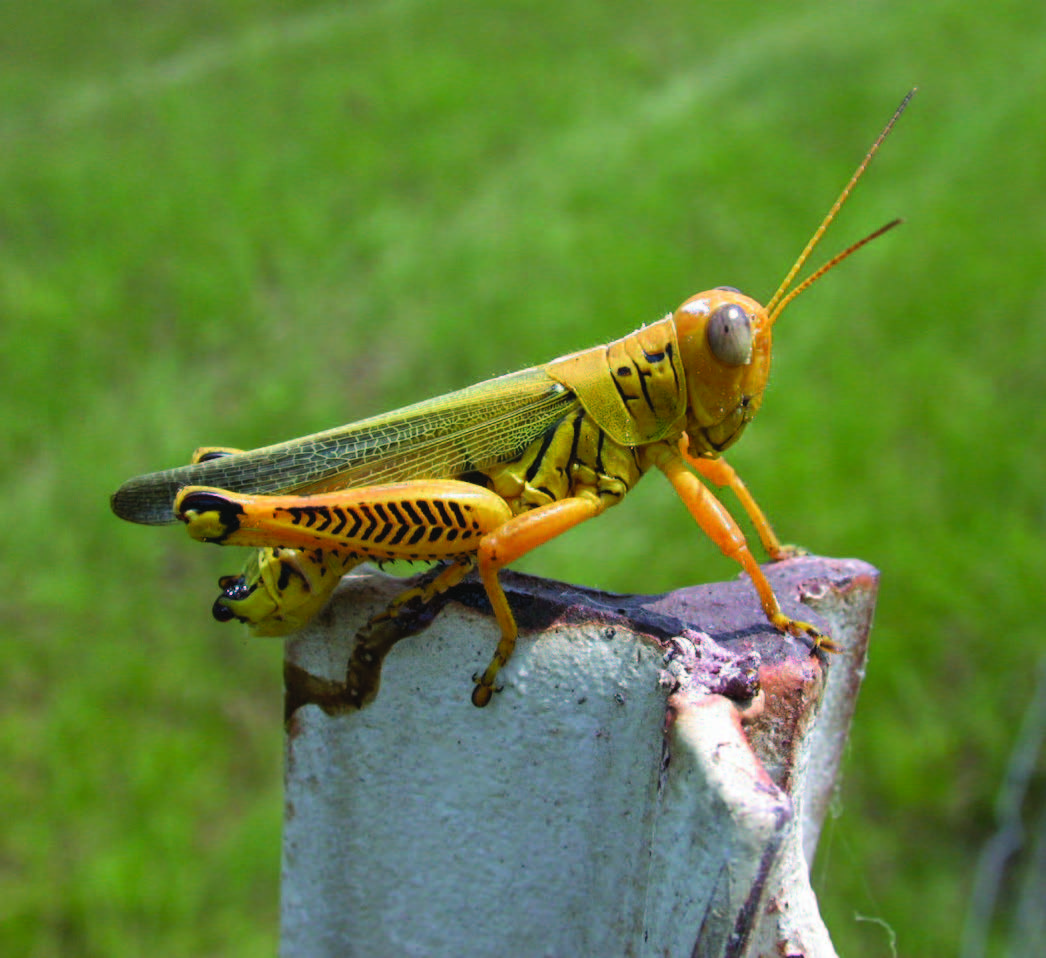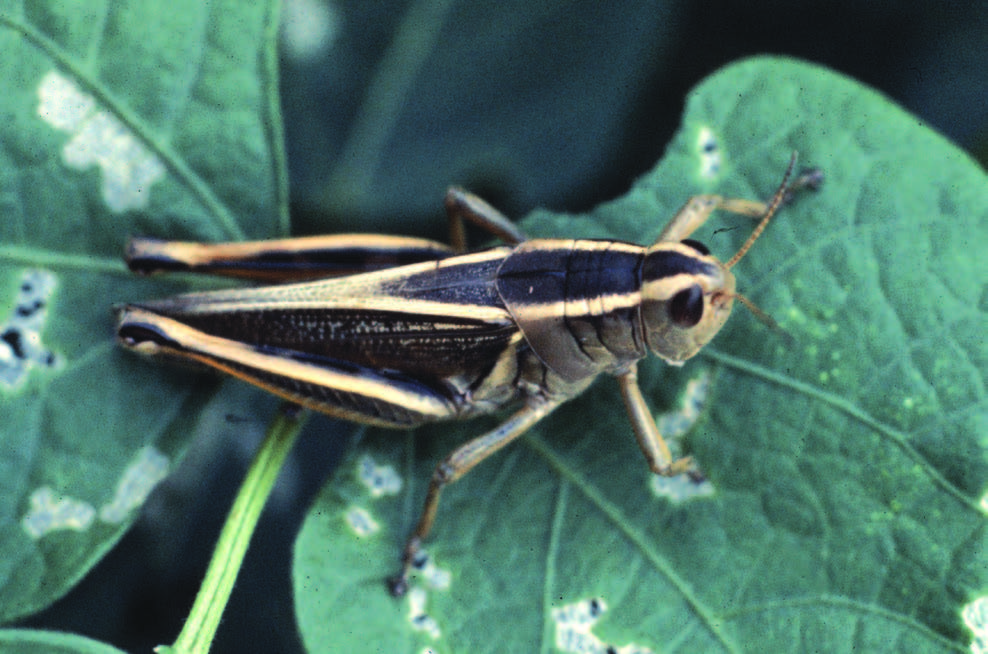Grasshopper Control in Gardens and Landscapes
Oklahoma, with its forest and grassland landscapes is blessed (or cursed) with more than 130 resident species of grasshoppers. Fortunately, only 4 or 5 of them ever become pest problems. The redlegged, migratory, differential, and two-striped grasshoppers are major pest species, with the differential and two-striped being the main culprits causing damage to ornamental and vegetable plants. Grasshoppers are more of a problem in rural communities, especially if they are surrounded by pastures or rangeland, or urban fringe areas that contain large amounts of ground overgrown with weeds and vegetation. Grasshoppers are difficult to control in the urban landscape, but homeowners can reduce their impact through the use of barriers and insecticides, and by selecting plants less prone to damage.
Biology
Regarding grasshopper biology; one size does NOT fit all, but they all possess some similarities. All grasshoppers undergo gradual metamorphosis and have three life stages: the egg, nymph, and adult. Grasshopper eggs are laid in pods containing from 8-30 eggs, and deposited in the soil. Grasshoppers lay eggs during the fall in non-crop landscapes such as ditches, fencerows, shelter-belts, and weedy disturbed areas, or sometimes in harvested crop fields and pastures. The eggs hatch the following spring (April-June). Nymphs grow through 5 instars before becoming adults, shedding their cuticle each time. It usually takes the nymphs from 35-50 days to become adults. Most grasshoppers overwinter as eggs and produce only one generation each year, but differences in spring temperatures and successive emergence of different species make it seem like there is an endless “hatch” throughout the spring and summer.
Figure 1. Differential grasshopper
Figure 2. Two-striped grasshopper. (Cranshaw, Whitney.
Colorado State University. Image 1326160. www.insectimages.org. April 16, 2004)
Damage
Grasshoppers eat plants, but most specialize on grasses or broadleaf plants. Pest species, on the other hand, feed on a wide variety of plants and will readily switch from grasses to broadleaves. As nymphs, grasshoppers tend to congregate and remain near their hatching areas. They will remain there as long as there is an adequate supply of food and shelter. When food runs out they will move. Immature grasshoppers can’t move very far, because they don’t have wings, but winged adults can fly for miles in search of new food sources. Hungry grasshoppers like gardens because they have optimal moisture and excellent plant growing conditions that provide an abundant food supply.
Grasshopper Management
People become alarmed when grasshoppers suddenly appear and begin feeding on prized flowers, vegetables, and ornamental plants. The distress can turn to frustration when grasshoppers are still seen after plants have been sprayed. In most situations, the spray worked and killed the grasshoppers that were there, but there is simply more grasshoppers moving in to take their place. The insecticides available for grasshopper control have a limited residual activity and will not kill new arrivals after several days. Grasshopper management in the garden and landscape requires patience, and when possible, cooperation with your neighbors. The following suggestions are offered for managing grasshoppers:
- Select plants from the following list, which was developed by extension horticulturalists
John Cooper and Stan Lovelace of the Texas Cooperative Extension Service as they observed
grasshoppers feeding in Denton County in 1998 (As reported by Dr. Mike Merchant, Extension
Entomologist, Dallas).
Preferred Slight Damage Not Preferred Althea Flowering Almond American beautyberry Amaryllis Grape Artemisia Bachelor’s buttons Hardy aster Bridal wreath spirea Bush honeysuckle Confederate jasmine Butterfly bush Coralberry Canna lily Crapemyrtle Cherry laurel Dwarf yaupon Day lily Dwarf burning bush Elaeagnus Dwarf Mexican petunia Hardy hibiscus Euonymus Iris Forsythia Liriope Juniper Mondograss Lantana Mums Mexican bush sage Peach Moss rose Photinia Nandina Privet Passionvine Rose Perennial dianthus Tradescantia Persian lilac Wegelia Rock rose Wisteria Salvia greggii Verbena (perennial) - Find hatching sites in surrounding areas and spot treat them with registered insecticides. Either flag those areas and treat them, or, in more suburban areas, try and work with your neighbors to find the sites and develop a neighborhood-wide control program. Best control is achieved if applied to immature grasshoppers in the 2nd and 3rd instar (less than 1/2 inch long).
- Purchase floating row covers to protect vegetables and prized plants. These fabrics permit sunlight to get through and allow for air circulation, yet are strong enough to keep grasshoppers from feeding. They can be sprayed with an appropriate insecticide to enhance their effectiveness. If the plants being protected require pollination (such as cucurbits), they may have to be hand-pollinated. Floating row covers are available at garden and nursery supply stores.
- Poultry, especially guinea hens, are effective predators. They may be useful for gardeners who live in rural areas and have room and interest in keeping them.
Control with Insecticides
Insecticides: Several insecticides are registered and effective at killing grasshoppers. Insecticides work better on small grasshoppers because it takes less active ingredient to kill them. If a single rate is applied (as is suggested in many labels) it will work better and kill grasshoppers longer if they are small.
Temperature and sunlight: Insecticides start to break down as soon as they are mixed with water. They also
break down when exposed to sunlight, and the breakdown process speeds up as temperatures
increase. Thus, in the summer when temperatures are high and sunlight intense, most
insecticides will work for about 24 hours. As summer progresses, grasshoppers get
bigger, move faster and feed more intensely. All of this means that sprays will need
to be repeated to keep plants protected with an insecticide late in the growing season.
Border treatments: Home yards and gardens in rural areas that are surrounded by range or pastures are
subject to invasion by grasshoppers from those areas. Irrigated yards and gardens
are an “oasis” for grasshoppers during the heat of the dry summer months. The best
way to control grasshoppers in this situation is to prevent them from ever entering
the yard. That can best be accomplished by treating the surrounding range and pasture
lands to control the grasshoppers as described in EPP-7196, Grasshopper Management
in Rangeland, Pastures, and Crops. If preventative control is not possible, the best
alternative is to make a border treatment around the yard and garden. Generally, grasshoppers
move across areas in ‘jumps’ as they search for suitable food. A homeowner can slow
or block their movement by treating all vegetation in a band or border perimeter around
the yard and/or garden with an insecticide. Border treatments that are wider provide
more effective control.
Yard and garden treatments: The line of last defense is to directly spray the plants that need to be protected.
However, none of the insecticides will totally prevent damage from large grasshoppers
because they have to do some feeding to pick up enough insecticide to die. Additionally,
even the pesticides with the longest lasting residues will have to be sprayed at 3-
to 4-day intervals when large numbers of large grasshoppers are constantly invading
a landscape. Consult EPP-7306 Ornamental and Lawn Pest Control for Homeowners, or
E-832, OSU Extension Agent’s Handbook of Insect, Plant Disease, and Weed Control for
specific information on available products for control of grasshoppers.
Biological control: Several botanical and biological products are sold to manage grasshoppers. Nosema
locustae is a protozoan microbe that causes disease in grasshoppers. Its resting spores
are mixed into a bait which is then spread in areas with grasshoppers. The grasshoppers
eat the bait and microbe spores, which then infect and kill the grasshoppers. Under
the best conditions, these products can provide 30-40% mortality of grasshopper populations
and under the wrong conditions (low dose, large grasshoppers and high temperatures)
will provide little effective control.
Beauveria bassiana is another microbe (fungus) disease that can kill grasshoppers if sprayed on plants
and they eat the spores. The fungus then infects and kills the insects. However, at
best, it will provide moderate control and little to no control during the hot and
dry summer conditions in Oklahoma.
Table 2.
| Insecticide | Trade names | For use on | Group | Comments |
|---|---|---|---|---|
| Acephate | Ortho Systemic Insect Killer | Ornamentals only | Organophosphate | Lasts several days, is systemic, fast acting, effective |
| Carbaryl | Ferti-lome and others | Pasture/yard/garden | Carbamate | Fast acting; moderately effective; |
| Nosema locustae | Nolo Bait, Semaspore, and others | Yard and garden | Biological | Perishable; low effectiveness, slow acting |
| Esfenvalerate | Ortho esfenvalerate and others | Yard and garden | pyrethroid | Fast acting; moderate residual period; very effective; |
| Lambda-cyhalothrin | Spectracide | Yard and garden | pyrethroid | As above |
| Cyfluthrin | Bayer Advanced Garden | Yard and garden | pyrethroid | As above |
| Pyrethrins | Safer pyrethrin and others | Yard and garden | Botanical extract | Short residual; low effectiveness; fast acting; certified organic |
| Azadiractin | AzaMax, Bioneem, and others | Yard and garden | Botanical extract | As above; primarily active against nymphs |
Biological Grasshopper Bait
Buglogical Control Systems
PO Box 32046,
Tucson, AZ 85751-2046
Phone/Fax: (520) 298-4400
E:mail: info@buglogical.com
NoLo Bait
Biocontrol Network
5116 Williamsburg Rd.
Brentwood, TN 37027
Phone/Fax: (800) 441-BUGS(2847)
Semaspore
Planet Natural
612 Gold Ave.
Bozeman, MT 59715
Phone Orders: (800) 289-6656 or (406) 587-5891
FAX: 406-587-0223
E-mail: info@planetnatural.com
https://www.planetnatural.com/
Semaspore
Hydro Gardens
P.O. Box 25845
Colorado Springs, CO 80936-5845
Phone: (888) 693-0578
E:mail: hgi@hydro-gardens.com
NoLo Bait
Harmony Farm Supply
3244 Gravenstein Highway, No. B
Sebastopol, CA 95472
Phone: (707) 823-9125
FAX 707-823-1734
Tom A. Royer
Extension Entomologist
Eric Rebek
Extension Entomologist


